Greg Taylor's Study - Updated: What are we to make of Moran?
Oct 24, 2019 1:51:23 GMT
Post by Admin on Oct 24, 2019 1:51:23 GMT
Many of you will recall Greg Taylor's excellent study summarizing how William "Ambrose" Moran's claims to the Catholic episcopacy compare to the actual evidence of this episcopacy or rather, the lack thereof.
Mr. Taylor has recently updated his study to include new information and we gratefully present it below. A PDF of Mr. Taylor's study is available here: Ambrose Moran Findings updated.pdf (2.5 MB)
May it be a blessing to those who may still be in ignorance of the facts of this case and innocently believe the serious 'misrepresentations' Moran has made of his dubious episcopal lineage.
***
What are we to make of William “Ambrose” Moran?
As to the first, the picture of Ambrose Moran and Cardinal Slipyj [APPENDIX B] is clearly a doctored image. So far, I am aware of at least three separate explanations from its owner. In October 2015, in Kentucky, Ambrose said that the picture was real but that as he had been standing further back and Slipyj slightly further forward, the light struck them in a slightly different way. In short, he said it was a trick of the light which made the image look doctored. In July 2018, in Ohio, he avowed that the unusual appearance of the picture was because, as it was being taken, Cardinal Slipyj tripped or stumbled or fell forwards slightly. In the recent document sent to some of the faithful and titled “Reply to 23 Points,” the answer given was simply “Metropolitan Ambrose did not take the photos, they were provided to him.” And yet he has vouched for this picture’s authenticity in the past, he supplied it to us, and in one version (below), at the foot of the image can clearly be read the words: “St. Sophia Cathedral – Rome – following Consecration of Bp. Ambrose”. These words are written in pen, in Bishop Ambrose’s own handwriting. Therefore it is simply not good enough, not credible nor for that matter reasonable to reply by saying, in effect: ‘I have no idea, that picture was given to me by someone, I’m not responsible for it.’ The fake appearance of the image is sufficiently obvious, it is the only picture out of all the hundreds showing these two men together in each other’s company, and he has written his own caption at the bottom which claims that it is genuine. Furthermore, the fact that he has now given at least three separate explanations which I am aware of, each distinct and each equally unconvincing, suggests a certain lack of candour at the very least. This raises the question: “Why?” Why does the picture exist to begin with? Why has he changed his story and given different and distinct explanations for it? And why have we still not heard anything at all convincing?
As to the letter, the document purporting to be a letter from Bishop Isidore Borecky [APPENDIX F] has the letterhead of the Eparchy of Toronto but no reference code at the top. Furthermore, a careful examination of the signature of the bottom shows that it is quite obviously identical to the letter of 1975 accepting Fr. Moran into the Eparchy for a two-year trial period [APPENDIX E]. The signature has been copied and pasted, one can see anomalies where the original signature crossed over the printed name (the top of the “B” in the signature “Borecky,” which crosses over the typed words “Our Lord” in the original letter, for example has had to be fudged and looks very unconvincing when viewed close-up). Even the smudge marks and little dots next to the signature are identical. It is a clear forgery. Again, one is left to ask the important question: “Why?”
One thing which might yield interesting results would be to look into the man called “Dimitri” Gaines and discover who exactly he was. If I am right, then he was just some guy, a mate of Ambrose, an American ex-Lutheran who joined Ambrose’s tiny vagus garage-bishop group some time in the 80s or 90s. Ambrose himself told me, when asked, that Dimitri was the man’s religious name, and that he was an ex-Lutheran before becoming “Ukrainian rite” with them. The question about “Dimitri” Gaines was off the cuff. He answered unsuspectingly. Had he been a little more on his guard, I think he may not have admitted that. And yet Gaines was supposedly the co-consecrator, alongside Cardinal Slipyj and Bishop Borecky, in St. Sophia’s Cathedral, Rome, in 1976. He supposedly was chosen to personally represent Maximos V Hakim, the Lebanese patriarch, at that momentous occasion. He wasn’t Lebanese and as far as we know, didn’t speak a word of French or Arabic, and indeed as far as we know, he wasn’t even on the “Ukrainian scene” back in 1976 – all the pictures of him are from the 80s or 90s. And in all those pictures, he is clearly dressed and acting as an arch-priest alongside Ambrose, who is vested and acting as bishop [APPENDICES J, K & L]. And yet he was supposedly already a bishop in 1976? And we have to accept this incredible claim, because, if it turns out that Gaines’s signature as a co-consecrator on the certificate is a genuine signature of a man who was not a bishop, then that alone undermines the certificate as a whole. Ambrose needed three signatures on the certificate. That one of them should be Cardinal Slipyj was obvious, he is the starring role in his story and sufficiently famous that examples of his signature are out there. Isidore Borecky was an obvious choice for the second name, after all, he had corresponded with Fr. Moran in the 1970s and so a copy of his signature was relatively easy. But a third signatory may have presented a problem. It is not unlikely that Moran “solved” this problem by simply inventing a fictitious bishop and getting his close friend and co-conspirator to sign it.
The Other Pictures
Many pictures are entirely irrelevant since they do not show Moran (the pictures of Cardinal Slipyj in Rome, for example, or of St. Sophia Cathedral).
Recommendations
For anyone who is not yet satisfied with the character and status of Ambrose Moran, to say nothing of his reliability and honesty, the following lines of enquiry might help to satisfy any remaining doubt.
[A copy of this report was sent to Fr. Pfeiffer and Fr. Hewko on 12th Jan., 2019. Below is the same report containing the same findings, very lightly edited.]
London, 12th Jan, 2019
Some months ago I was asked by Fr. Pfeiffer to put something together regarding Ambrose Moran and what conclusions I had come to concerning his incredible tale. I didn’t manage to do that in the end, though having spent several days in Kentucky and Ohio, pouring over the evidence and discussing it back and forth, I did express my misgivings. I also strongly recommended that no further action in the matter should be taken until some serious issues were resolved. Partly through apathy or laziness and partly because I hoped it would be unnecessary, I prepared nothing in written form. It is only now, in view of the situation in which we find ourselves, a situation not of my making, and with a large number of people asking me about it, that I feel I ought to put pen to paper and see what sense can be made of it all.
The question of Ambrose Moran is far from resolved. As I think anyone who has been involved in this business will admit, I have tried giving this man the benefit of the doubt and have been concerned that he should be seen to have a fair hearing. I have met and talked with him several times and at length, have listened to what he has to say, have been prepared to take his word at face value and have tried seeing things in his favour. I have defended him against what I perceived to be unjust attacks (that he was never baptised a Catholic, for example). And yet as to his entire story of who he is, I remain unconvinced, and since my last visit, even less convinced than ever before. The more I have seen, the less I like it.
First, let me summarise where I think the problem lies.
First, let me summarise where I think the problem lies.
Here is what one can reasonably accept:
• That he is a baptised Catholic from the time of his birth.
• That he went to Catholic school and Catholic minor seminary.
• That he professes the Catholic Faith today. • That he was for a certain period accepted as a priest of the Eparchy of Toronto, and therefore, as a Catholic priest; and that during that relatively limited period of time, he worked in Catholic parishes.
• That he might have valid orders as a bishop, albeit via the schismatic Orthodox.
What I don’t think one can reasonably accept, is the following:
What I don’t think one can reasonably accept, is the following:
• That he has anything Ukrainian at all in his background
• That he was consecrated bishop by Cardinal Slipyj in 1976
• That he is a Metropolitan Archbishop with the style “His Beatitude”
• That he currently possesses ordinary jurisdiction
• That he was always and only Catholic and never had even the slightest dalliance with the Orthodox.
There are other things which I don’t think I would accept, such as his claim to royalty, but that really is a great deal less important. In brief, the weak link in the chain is Cardinal Slipyj. There are precisely three pieces of documentary evidence which connect Bishop Ambrose with Cardinal Slipyj. They are the picture purporting to show the two of them outside St. Sophia’s Cathedral in Rome, the letter purportedly from Bishop Isidore Borecky in 1976, stating that Ambrose is made Metropolitan Archbishop and the successor of Cardinal Slipyj, and the alleged consecration certificate supposedly signed by Slipyj in 1976. All three of these are fraudulent documents, as I will show shortly, and a satisfactory explanation for any of them has yet to be found.
The Picture
The Picture
As to the first, the picture of Ambrose Moran and Cardinal Slipyj [APPENDIX B] is clearly a doctored image. So far, I am aware of at least three separate explanations from its owner. In October 2015, in Kentucky, Ambrose said that the picture was real but that as he had been standing further back and Slipyj slightly further forward, the light struck them in a slightly different way. In short, he said it was a trick of the light which made the image look doctored. In July 2018, in Ohio, he avowed that the unusual appearance of the picture was because, as it was being taken, Cardinal Slipyj tripped or stumbled or fell forwards slightly. In the recent document sent to some of the faithful and titled “Reply to 23 Points,” the answer given was simply “Metropolitan Ambrose did not take the photos, they were provided to him.” And yet he has vouched for this picture’s authenticity in the past, he supplied it to us, and in one version (below), at the foot of the image can clearly be read the words: “St. Sophia Cathedral – Rome – following Consecration of Bp. Ambrose”. These words are written in pen, in Bishop Ambrose’s own handwriting. Therefore it is simply not good enough, not credible nor for that matter reasonable to reply by saying, in effect: ‘I have no idea, that picture was given to me by someone, I’m not responsible for it.’ The fake appearance of the image is sufficiently obvious, it is the only picture out of all the hundreds showing these two men together in each other’s company, and he has written his own caption at the bottom which claims that it is genuine. Furthermore, the fact that he has now given at least three separate explanations which I am aware of, each distinct and each equally unconvincing, suggests a certain lack of candour at the very least. This raises the question: “Why?” Why does the picture exist to begin with? Why has he changed his story and given different and distinct explanations for it? And why have we still not heard anything at all convincing?
It is perhaps worth noting that Moran looks too old in the picture. He looks to be in his 30s, although the picture is supposed to have been taken in 1976. It looks more like a 1980s picture of Moran pasted together with a 1970s picture of Slipyj. I hadn’t noticed that until it was pointed it to me last summer, but it is true. The forgery was probably done in the 1980s.
The Letter
As to the letter, the document purporting to be a letter from Bishop Isidore Borecky [APPENDIX F] has the letterhead of the Eparchy of Toronto but no reference code at the top. Furthermore, a careful examination of the signature of the bottom shows that it is quite obviously identical to the letter of 1975 accepting Fr. Moran into the Eparchy for a two-year trial period [APPENDIX E]. The signature has been copied and pasted, one can see anomalies where the original signature crossed over the printed name (the top of the “B” in the signature “Borecky,” which crosses over the typed words “Our Lord” in the original letter, for example has had to be fudged and looks very unconvincing when viewed close-up). Even the smudge marks and little dots next to the signature are identical. It is a clear forgery. Again, one is left to ask the important question: “Why?”
Also worthy of note is that this letter is the only one directly connecting Ambrose and Slipyj. So the one and only picture and the one and only letter connecting the two men each turn out to be forgeries. What is his explanation for this forged letter? Is he simply going to say “I don’t know, someone gave it to me, I’m not responsible…” as he did recently with the fake picture? What are the chances that a man claiming to be a Ukrainian Archbishop and to have been consecrated by possibly the most famous Ukrainian Catholic of the whole 20th Century would have only one letter and one picture in his possession relating to this, the most important event of his life, and would somehow have failed to notice that either of them was a forgery? That is not reasonable; I don’t think any reasonable person could accept that.
As to why this forged letter exists, a clue may lie in the contents of the letter, a letter which one strongly suspects was written by Ambrose himself. It begins:
This again, appears to me to be somewhat contrived. For example, why say that it is “signed and sealed” – if he has in his possession the document from the Cardinal who consecrated him, then of course it is signed and sealed. A signature and a seal are to prove authenticity. This is like saying ‘I have in my possession your Consecration Document, and it is authentic.’ I somehow can’t imagine a real Bishop Isidore Borecky saying that. Then there is the reference to it being also signed by the other co-consecrators. This is surely a slip-up. There was (allegedly) only one other co-consecrator, the American ex-Lutheran who called himself “Dimitri” Gaines. Why did he not mention who the co-consecrators were? Why no mention of “Dimitri” Gaines? I suspect the answer is that the forger had not yet decided exactly who “the co-consecrators” were to have been.
Here is another interesting point. There is no letter from Cardinal Cooke saying, ‘Bishop Borecky has just told me that you were consecrated in Rome by Slipyj, what’s going on, is this true?’ or some other such response. There is one picture of Ambrose and Cardinal Cooke together, the former in bishop’s purple, the latter in his Cardinal’s red. [APPENDIX C] The picture is also a forgery, just like the picture of Slipyj and Ambrose. One can clearly see that a picture of Cooke has been superimposed onto a picture of Ambrose. Again, only one picture of the two of them, the only evidence connecting them, and it turns out to be a forgery – what are the odds? And why? Was it created to back up this reference in the forged letter?
In passing, I cannot help wondering whether anyone has ever seen the alleged Cardinal Slipyj consecration certificate in Ukrainian, to which the letter refers? It is worth mentioning only because if, as I have reason to believe, Ambrose does not come from a Ukrainian background and does not speak or write fluent Ukrainian, and if, as seems more than likely he is the one responsible for the forgery, then the existence of a forged certificate identical to the English one but written in Ukrainian is an unlikely proposition at best.
“Most Reverend and dear Bishop Amvrosij: With our most sincere congratulations and cooperation upon your consecration in Rome by His Beatitude Patriarch Josef Cardinal Slipyj and our humble self…”
“With our most sincere congratulations…” is a phrase which sounds normal enough, but “our congratulations and cooperation” sounds, in my humble opinion, somewhat contrived. It is the first time the author (allegedly Bishop Isidore Borecky) refers to the fact that he helped Slipyj to consecrate Moran, before going on to mention “your consecration in Rome by … Slipyj and our humble self” which is the second reference. So the author, “Borecky,” begins by reminding Moran that he helped Slipyj to consecrate him; he then goes on to remind Moran that he helped Slipyj to consecrate him. As I say, it comes across as a little too contrived, he’s trying a little too hard here.
Next the author informs Moran (although really, the way the letter is written, it is to inform whomever Moran shows the letter to), that he has in his possession:
“…the Consecration or Cheritonia Document in both Unranian [sic] and English signed and sealed by His Beatitude and the Co-Consecrators.”
“We agree to bring this announcement at your request to Cardinal Cooke of New York…”
In passing, I cannot help wondering whether anyone has ever seen the alleged Cardinal Slipyj consecration certificate in Ukrainian, to which the letter refers? It is worth mentioning only because if, as I have reason to believe, Ambrose does not come from a Ukrainian background and does not speak or write fluent Ukrainian, and if, as seems more than likely he is the one responsible for the forgery, then the existence of a forged certificate identical to the English one but written in Ukrainian is an unlikely proposition at best.
The reference in the second half of the letter to Ambrose being appointed “Metropolitan Archbishop and CoadjutorSuccessor” by Slipyj is entirely superfluous and gratuitous. It is an extraordinary claim which requires extraordinary evidence, or at least some evidence, not least because it is being made in a forged document and because the facts contradict it. The letter says that Slipyj “will announce…” all this – did he, in fact, announce any such thing? No. Complex stories involving modernist intrigue and so forth notwithstanding, the fact remains that the only evidence of Ambrose being a “Metropolitan Archbishop Coadjutor Successor” is a forgery. Just as the only two pictures which support this letter, the fake Cardinal Slipyj picture and the bogus one with Cardinal Cooke, are also both forgeries.
We will mention later the Police reports from Colorado. They demonstrate beyond any doubt what is already demonstrated by these forged pictures and documents alone: that Ambrose Moran is a liar and not above a bit of fairly serious fraud. We have a fake picture of him and Cardinal Slipyj which was obtained from him and which he now (understandably) wishes to distance himself from, despite it being captioned in his own handwriting. We also have a fake letter purporting to come from “Isidore Borecky” reminding him that he had helped Slipyj to consecrate him and telling him that he is now made “Metropolitan Archbishop and Coadjutor-Successor,” a letter whose signature has clearly been lifted directly from the genuine and far less impressive letter of Feb. 1975. The fake letter also says that Cardinal Cooke will be informed – and lo and behold, we also have a fake picture of Ambrose with Cardinal Cooke. And like the fake Slipyj picture, the fake Cardinal Cooke picture is also captioned in Ambrose’s own hand, which instantly defeats any sophisms about “I didn’t take the picture so I’m not responsible…” and so on.
There is other circumstantial evidence which also points to his supposed connection to Cardinal Slipyj being nothing more than another spurious fantasy dreamt up by a man who cannot be relied on to tell the truth. Personal contact with the man leaves one noticing the odd fact that his stories about Slipyj are always the same and always the sort of thing which everyone knew, about how in the Gulag they lined up the priests and shot them one after the other, etc. None of his stories about Slipyj have any personal connection, they are totally devoid of personal details, the little details which people always have when they knew, were friends with or worked-closely with someone, and which only they could know. It is as though Ambrose has no personal anecdotes about himself and Slipyj (the sort of thing which might begin: “Then there was the time when Cardinal Slipyj slapped me on the back and said to me…”). This does not ring true if we are to believe that he was personally chosen by Slipyj to be secretly consecrated, at an extremely young age (27 – well below the canonical age) and very soon after appointed (still aged 27) as Metropolitan Archbishop and Slipyj’s Coadjutor-Successor. It sounds almost silly having to point this out, it’s so obvious. Likewise, does he even speak Ukrainian? Does he speak Russian? One might have thought so, given that he was supposedly trained by the Russian Jesuits and chosen by Slipyj to go behind the lines “like a spy” (in his own words), behind the iron curtain. But again, from personal contact with the man, I don’t think he speaks either language. I think he knows a few pat phrases in Ukrainian, the sort of thing that every Ukrainian-rite faithful might know, the equivalent of “Dominus vobiscum” or “per omnia saecula saeculorum” – but he really doesn’t seem to be able to speak fluent Ukrainian at all. His parents on his baptismal certificate have “ordinary” New York names (Moran is Scottish, I think, or Irish) and from his baptism in 1949 onwards there is no hint of anything Ukrainian or Eastern-rite about him until suddenly he is a Ukrainian-rite cleric in the mid-1970s. Isn’t that at least a little odd?
The Consecration Certificate
One thing which might yield interesting results would be to look into the man called “Dimitri” Gaines and discover who exactly he was. If I am right, then he was just some guy, a mate of Ambrose, an American ex-Lutheran who joined Ambrose’s tiny vagus garage-bishop group some time in the 80s or 90s. Ambrose himself told me, when asked, that Dimitri was the man’s religious name, and that he was an ex-Lutheran before becoming “Ukrainian rite” with them. The question about “Dimitri” Gaines was off the cuff. He answered unsuspectingly. Had he been a little more on his guard, I think he may not have admitted that. And yet Gaines was supposedly the co-consecrator, alongside Cardinal Slipyj and Bishop Borecky, in St. Sophia’s Cathedral, Rome, in 1976. He supposedly was chosen to personally represent Maximos V Hakim, the Lebanese patriarch, at that momentous occasion. He wasn’t Lebanese and as far as we know, didn’t speak a word of French or Arabic, and indeed as far as we know, he wasn’t even on the “Ukrainian scene” back in 1976 – all the pictures of him are from the 80s or 90s. And in all those pictures, he is clearly dressed and acting as an arch-priest alongside Ambrose, who is vested and acting as bishop [APPENDICES J, K & L]. And yet he was supposedly already a bishop in 1976? And we have to accept this incredible claim, because, if it turns out that Gaines’s signature as a co-consecrator on the certificate is a genuine signature of a man who was not a bishop, then that alone undermines the certificate as a whole. Ambrose needed three signatures on the certificate. That one of them should be Cardinal Slipyj was obvious, he is the starring role in his story and sufficiently famous that examples of his signature are out there. Isidore Borecky was an obvious choice for the second name, after all, he had corresponded with Fr. Moran in the 1970s and so a copy of his signature was relatively easy. But a third signatory may have presented a problem. It is not unlikely that Moran “solved” this problem by simply inventing a fictitious bishop and getting his close friend and co-conspirator to sign it.
I have seen the original certificate. It is in a narrow gold frame with a glass front. I saw it in the summer of 2018 in Ohio. There is no doubt at all that that was the original “Slipyj” consecration certificate. For reference, I have included a photograph of that very same original certificate, in the same frame, taken by Fr. Pfeiffer (who is partly reflected in the glass) in 2015, mounted in a display case at Ambrose Moran’s then- home in Colorado [APPENDIX I]. It is unquestionably the same one. Once again, Ambrose has captioned that picture of the certificate in his own hand: “Consecration Certificate in English of Metropolitan Archbishop Ambrose.” I have held that very certificate in my hands: I did not take it out of its frame, but there was no need to. The gold seal, which looks three-dimensional in a photo, is clearly two-dimensional when viewed close up in real life. Furthermore the type is highly suspect. I am convinced that any forensic investigator who works in the insurance fraud industry would confirm that that certificate was typed on the same machine used to type the fake 1976 Borecky-Slipyj letter mentioned above. Take a look close-up at the way the Capital ‘M’s are badly printed in exactly the same way, for example. They may not be able to tell when it was typed using just an image and not the original, but if they could I would be willing to bet that both documents were created in the 1980s, not the 1970s.
Incidentally, that that would be consistent with the unusual conundrum of his name: his surname is simply “Moran” from his baptism in 1949 all the way through to the end of the 1970s, and it seems to become “Moran-Dolgorouky” from the 1980s onwards. Both the fake Borecky-Slipyj letter and the consecration certificate refer to him as “MoranDolgorouky”. No other picture or document from the 1970s or earlier can be found with the name “Dolgorouky.” The Feb. 1975 letter of Borecky granting him a two-year trial period in the Eparchy of Toronto, for example, refers to him simply as “Rev. William E. Moran”. Why might that be? I think it is because his royal pedigree is of the same order as Metropolitan-Coadjutor pedigree: a fantasy from the 1980s.
It has been pointed out to me more than once that a letter was discovered recently in the Ukrainian Catholic archives in Rome, a letter from Bishop Isidore Borecky writing to Cardinal Slipyj and saying, in essence, “I have been approached by a bishop and two priests (Nicholas Ilnyicki with Moran and Ropke) asking to be taken into the Eparchy. Is this OK by you?” This, it might be thought, proves a connection between Moran and Slipyj. Well, yes and no. Yes, indirectly, but not in the way that it would need to. It proves first of all that Moran’s claim that in 1974 he was a priest of the Archeparchy of Lviv who was then loaned to Borecky by Slipyj is not true, since then we would see the opposite: instead of Borecky writing to Slipyj inform him about a bishop and two priests who have approached him and asking to be taken under his wing, we would expect to see Slipyj writing to Borecky to tell him about one of his priests whom he was sending him and who would be arriving shortly. Secondly, it does not connect Moran directly with Slipyj. It only connects him with Borecky, and Borecky with Slipyj. That Borecky can be connected with Slipyj is hardly surprising: one was a Ukrainian Catholic bishop, the other a Ukrainian Catholic Cardinal and Patriarch. But it leaves the same problem. Where is the evidence connecting Moran and Slipyj directly? Why is there no 1974 letter from Slipyj, for example, saying “To Whom It May Concern, the bearer of this letter is one of my priests of the Archeparchy of Lviv…” etc..? Once again, the only things connecting the two men are forgeries and fakes. In short, this letter which I have not yet seen, if it says what I understand it to say, does not help Moran’s case. It only adds further questions and serves to further contradict his own claims.
The Other Pictures
Many pictures are entirely irrelevant since they do not show Moran (the pictures of Cardinal Slipyj in Rome, for example, or of St. Sophia Cathedral).
I think, if you look at all of the pictures of Moran, taken as a whole they can be broken down into three broad categories.
• The pictures from the 1970s as a priest;
• The pictures from the 1980s onwards as a bishop;
• The pictures of him with important people.
The ‘Important People’ Pictures - some of the pictures of him with important people are either taken as a fan would take a “selfie” with a celebrity in our own day (the picture of Ambrose and Dr. Joyce Brothers looks a little like that to me, as though he came up to her at the end of a talk, and asked to have her picture taken with him, as one might ask for an autograph). They are obviously posed, and they are one-offs. We have one or two pictures of him alongside Novus Ordo bishops. ‘Once only and never again’ is how a forger, a faker, a confidence trickster acts. They have to keep moving so as not to be found out. It is like the laymen who pretend to be priests: if they show up one time and have what looks like a celebret or some documentation, for a one-off, they may well get away with it; whereas if they come back a second or third week in a row, somebody is going to look a little closer and they risk getting caught; worse, if they are caught, others might be alerted and forewarned. So they have to keep moving. I cannot prove definitively that that is what is going on here, but it fits and it fits a lot better than the fantastic story of the Coadjutor-Successor of Slipyj not being properly accepted by the modernist bishops even though they all knew full well who he was (how convenient!).
Other pictures in this category are obvious forgeries. That is something the dozen-or-so forgeries I have seen from Ambrose all seem to have in common: they are all pictures of Ambrose with someone important. The Slipyj picture and the Cardinal Cooke picture have already been mentioned. The Pope John Paul II picture [APPENDIX D] is an obvious forgery too, a composite of two pictures, similar to that of Cardinal Cooke. Then there are the several forged pictures showing Archbishop Hrihorij (Gregory) of Holy Protection Cathedral, Chicago. There are at least five of these
that I know of, though more may exist. There exists a picture showing Hrihorij standing vested, in a church. Then there is the same picture with Moran pasted into the background (amusingly, it is the exact same picture of Moran which has been used to create the fake picture with Cardinal Slipij!) Then there is a third version of the same picture, in which Moran is missing but “Dimitri” Gaines has been added. Three different versions of the same picture! The one with only Hrihorij is clearly the original. The other two are clearly forgeries. Then there is the forged picture purporting to show both Moran and Hrihorij inside what I take to be Holy Protection Cathedral, at any rate they are standing at an iconostasis with the doors open. And there is also the picture of what appears at first glance to be three bishops in a row, used on Moran’s now-defunct website, at least two distinct versions of which exist. All fake.
that I know of, though more may exist. There exists a picture showing Hrihorij standing vested, in a church. Then there is the same picture with Moran pasted into the background (amusingly, it is the exact same picture of Moran which has been used to create the fake picture with Cardinal Slipij!) Then there is a third version of the same picture, in which Moran is missing but “Dimitri” Gaines has been added. Three different versions of the same picture! The one with only Hrihorij is clearly the original. The other two are clearly forgeries. Then there is the forged picture purporting to show both Moran and Hrihorij inside what I take to be Holy Protection Cathedral, at any rate they are standing at an iconostasis with the doors open. And there is also the picture of what appears at first glance to be three bishops in a row, used on Moran’s now-defunct website, at least two distinct versions of which exist. All fake.
These several forgeries involving Hrihorij are extremely troubling to anyone who is familiar with Ambrose’s story. If Ambrose’s episcopal consecration at the hands of Cardinal Slipyj is highly dubious and the subject of several forgeries to try support it, then that is his Catholic episcopal pedigree undermined; what then happens when we begin to suspect something about his other line of episcopal orders? He obtained them in Holy Protection Cathedral via Hrihorij, the same Hrihorij who, it now seems, is also the object of several fake pictures. This would need looking into afresh and with a keener eye than has been used hitherto. Once one realises that Ambrose is not above telling all sorts of lies for his own personal benefit, once one realises that his word means nothing (see the Colorado Police reports already mentioned if there is still any doubt at all about that!), then everything he says is suspect and needs looking at again. I would have been willing, previously, to accept on balance that he has valid episcopal orders, albeit via the Orthodox. Now I am not entirely sure even of that. It may turn out to be true after all, but as of this moment I think it is not certain. Why would he feel the need to forge pictures of himself and Hrihorij? It is not right.
Pictures from the 1980s Onwards - These all show him as a bishop. There are no pictures from the 1970s of him as a bishop, despite his claiming to have been consecrated in the mid-70s. Most of the pictures are non-liturgical, either they are not taken in the sanctuary or the subjects are not vested or both. The picture purporting to show Toronto Jesuits, for example, has some vested and some not, and is not in the sanctuary. The few liturgical functions seem almost entirely to be either weddings if they are in a ‘normal’ looking church, or not in a church at all (e.g. in a building with a tin roof, or in the small ‘house chapel’ in his then-home). Unlike the 1970s pictures, there are no ‘normal’ sized congregations, just a tiny number of people, smaller than a resistance function! “Dimtri” Gaines is present in some of them, though always as an archpriest. Like the “important people” pictures, these ceremonies seem always to be one-offs.
Pictures from the 1970s - These are the most authentic and speak the most highly for Ambrose, though I suppose we should call him “Fr. William Moran” when we are talking about this period. They show him working as a priest, in schools, in parishes, with lots of parishioners, nuns, etc. a context which is entirely absent from his later (80s, 90s and 2000s) pictures. There are two or three newspaper cuttings. Very often he is in the company of a Fr. John Ropke. One or two of them are obviously posed, which raises a question as to why the picture was taken. The picture of Fr. Moran in St. Nicholas Church, Passaic, for example. It is unquestionably the altar and sanctuary of the church, just as it is unquestionably Fr. Moran in the picture wearing vestments. Yet there is nothing on the altar and the candles are not lit. Mass is not going on nor is it about to start. No servers or anyone else can be seen, he appears to be on his own except for the person who took the picture. So why was the picture taken? Who knows, but I digress…
The other thing which I find striking about this period is that there are so many pictures covering so comparatively short a time (almost all of them come from a two-year period in the mid-1970s) as compared to relatively few pictures from before or after. Why might that be?
I have mentioned above being told of the existence of a letter from Borecky to Slipyj, saying that he has been approached by a bishop and two priests (one of whom is Fr. Moran), and we know that in Feb. 1975 Borecky wrote to Moran to tell him that he was accepted as a priest of his diocese for a two-year trial period, after which time, “a review of your record will be made and the possibility of incardination will be discussed.” [APPENDIX E] We know that the two year period ran out. Next we see a “Fr. Basil Moran” writing to Borecky in 1980 [APPENDIX G] telling him that he is joining the Orthodox Church in America. We know from Fr. Tosi, Secretary of the Orthodox Church in America, who recently looked in the archives of that Church, that Moran did approach them and apply to join, that he applied to join as an Archimandrite (arch-priest) not as a bishop and that he was interviewed by them though they ultimately rejected him. We also know that there are no pictures or documents showing him working in parishes or schools as late as 1980, and that is hardly surprising: in the same letter, Moran states plainly that “I was under your jurisdiction for two years” and gives the dates as “February 14, 1975 to February 14, 1977.” So what really went on? Fr. Moran closes by telling Bishop Borecky:
What “canonical situation” requiring the “solution” of joining the Orthodox would that be, I wonder? And why “finally”? It sounds to me like he had been canonically homeless for the past three years. The 1975 letter shows Bishop Borecky giving him a two-year trial period “…after which the possibility of incardination will be discussed.” This 1980 letter demonstrates beyond reasonable doubt that Borecky chose not to incardinate him but sent him packing once those two years ran out. Why, we cannot be sure. I do not intend here to re-run his own long and complicated explanation for all of this. My own experience dealing with badly behaved boys in school has taught me that when a person’s explanation of their own conduct turns out to be improbably long and complicated, it is a sign that its narrator is not telling the truth. If a priest of the Resistance, Fr. Pfeiffer for example, had to explain their history, ordination and canonical standing, it would be remarkably simple and might go something like this: ‘I entered the SSPX seminary in 1988, was ordained by an SSPX bishop in 1994, worked as an SSPX priest until starting out in the Resistance in 2012.’ How’s that for a thirty-year history? It has a simplicity about it which only the truth can have, despite the fact that we are used to thinking of the Resistance, the SSPX and all the rest as requiring complicated, detailed explanations. This is a simplicity totally lacking in Moran’s story. No, his explanation sounds highly improbable to me. What I will note is that, whereas he claims that although he wrote those words to Borecky, he only did it to test Borecky’s response and never intended to carry out his stated intention, the letter itself appears to suggest otherwise. His letter opens by stating, not that “I will submit...” or “I intend to submit…” but that “I have submitted to the jurisdiction of Metropolitan Archbishop Theodosius of the Orthodox Church in America.” Thus Moran is reduced to having to falsifying his own witness, a letter which he himself wrote, because it contains the admission that he was only a priest of Toronto Eparchy for two years and by 1980 found himself in need of another “canonical solution.” Finally, his name has magically changed to “Basil” Moran, a name we do not encounter before or after this letter – why might that be? His explanation that Basil is really the same as William, the two being Eastern and Western versions of the same name, is typical of a practiced liar. If you come straight out with the claim and say it with a straight face, most people will not know any better and will not question it. Most people would blush to tell such a whopper or stammer or look away and thus give the game away; it needs practice to do it convincingly. In fact William is German in origin (Wilhelm), whereas Basil is Greek and comes from “Basileus” meaning a king. So that explanation is nonsense. I think it far more probable that “Basil” was a religious name which he assumed on submitting to the Orthodox Church in America (rather like “Dimitri” Gaines). That would also explain why we don’t see him being called “Basil” before or after, because he wasn’t with them before or after.
“I hope your grace will rejoice with me in this solution to my canonical situation which can now finally be resolved.”
Finally, to pre-empt a possible objection: there is no doubt that the 1980 letter is authentic. It came from within the Toronto Eparchy archives, has Moran’s correct address on the letterhead (Hicksville, NY) and nobody yet has so much as suggested that it is inauthentic so far, despite it having been the subject of much discussion. On the contrary, Moran has come up with a complicated and improbable-sounding explanation for its existence, which explanation has at least the merit of showing that he accepts that it is genuine. Finally, once again, I suspect that the same typewriter was used as mentioned above, though I could be mistaken. I think I detect some similarities, though only slight: perhaps it was typed a few years earlier than the fake letter and the fake consecration certificate, when the keys were not quite so worn out, though it is only a suspicion and I could be wrong about that. Again, a forensic insurance fraud specialist ought to be able to tell us.
I suspect it is far more likely that Moran, having been ordained a priest under who-knows-what conditions by Nicholas Ilnyicki (about whom we also know alarmingly little), was accepted into Toronto Eparchy for a trial period of two years. The two years ran out, the Toronto Eparchy did not wish to renew his credentials (who knows why?) and so he continued as a vagus priest of some sort. If we don’t know for sure, one reason for that is that Ambrose Moran has been less than candid and cannot be relied on to tell the truth. This would explain the remarkable but undeniable fact that all the unmistakably Catholic pictures are from this narrow two-year period, whereas there are comparatively few pictures from the three decades afterwards; it would also explain why even the pictures which do exist from those later decades leave something to be desired.
Recommendations
For anyone who is not yet satisfied with the character and status of Ambrose Moran, to say nothing of his reliability and honesty, the following lines of enquiry might help to satisfy any remaining doubt.
“Dimitri” Gaines. Find out all that can be learned about this man. Not nearly enough is known about him. His role in this alone is enough to sink Ambrose’s incredible story and yet we know virtually nothing about him. It goes without saying that any new information will need to be discovered without reference to Ambrose, since he is not trustworthy and cannot be relied on to tell the truth.
Nicholas Ilnyicki. Likewise, we don’t know nearly enough about him. He made William Moran a priest and it was he, as bishop, together with the two priests, Fr. Ropke and Fr. Moran, who approached the Toronto Eparchy, which is what gave Fr. Moran a brief two-year period as a Catholic priest in good standing. Find out more about him.
Forensic Document Analysis. Find a company which works in the insurance fraud industry and give them a pile of documents, as many documents relating to Ambrose and those connected to his incredible story as you can. Include everything. Don’t tell the company what anything is or why, tell them as little as possible, just ask them to compare and contrast. And then take the results seriously.
Police Reports. There are an alarming number of these from a relatively small part of the world (Colorado) and a relatively short period of time. Given that before moving to Colorado, Moran lived in New York, I would search around for similar Police reports from his old haunts: Hicksville, East Islip, Passaic, and so forth. My instinct tells me that people don’t change their ways easily and someone who is capable of this sort of fraud, several times in succession, sometimes even overlapping, in one place is a person who will have done it elsewhere too. The stuff about inviting young men back to his place to get drunk and stay the night is also troubling, as is the testimony of more than one of them that he creeped them out, that he hugged them too long or too hard “until it felt weird,” that they thought “he wanted to get me drunk and probably touch me,” “my Mum said she thought he was a child molester,” and all the rest. Check if this has happened anywhere else. There may be nothing in it, but equally there may be and it would help explain one or two things. The Colorado Police reports also make frequent mention of a Zelda Michaels – who is she? They say more than once that Ambrose belonged to “Pochrov Ministries” – what is that? Does anyone have any idea? Follow up what is in the reports.
Character Witnesses. One of the most unusual things is the way that we are forced to rely almost entirely on documents. Where are the people who remember him, who knew him? A Resistance priest who had to prove that he was ordained by the SSPX in the 1990s would be able to find people who remembered. I’m sure the same is true of a priest ordained in the 80s or 70s. Why can’t we find people who remember Ambrose Moran? Yes, the mid-70s was a long time ago. But there must still be some people from that era. My own parents were married around that time, I’m sure I could find a few people who knew them or even who were at the wedding if I really needed to. It isn’t that long ago. And what about people who knew him in the 1980s or 1990s or early 2000s?
Character Witnesses. One of the most unusual things is the way that we are forced to rely almost entirely on documents. Where are the people who remember him, who knew him? A Resistance priest who had to prove that he was ordained by the SSPX in the 1990s would be able to find people who remembered. I’m sure the same is true of a priest ordained in the 80s or 70s. Why can’t we find people who remember Ambrose Moran? Yes, the mid-70s was a long time ago. But there must still be some people from that era. My own parents were married around that time, I’m sure I could find a few people who knew them or even who were at the wedding if I really needed to. It isn’t that long ago. And what about people who knew him in the 1980s or 1990s or early 2000s?
In the meantime, I expect that many people will feel, as I do, that there is really no need for yet more time to be spent on research into the man, that we have more than enough evidence of lying, forging and general dishonesty, and that in any case any further research into so clearly untruthful and unreliable a man would be at best a fruitless, wasted effort and at worst might even become an unnecessary temptation. We will be keeping our distance and having nothing more to do with this man. Given that there are so many outstanding questions and so many problems with his story, given that Ambrose himself persists in insisting on the truth of things which are obviously false (even today, for example, he wears a pallium and refers to himself as “His Beatitude” despite the fact that there is no evidence whatever of his ever having had any connection to Cardinal Slipyj, much less that he was appointed his successor, and a good deal of evidence to the contrary!), given everything that is at stake, no Catholic should have anything more to do with him. Perhaps further enquiries would turn up something extraordinary which would vindicate him and put all of this to rest, but I very much doubt it.
Having studied as much of the evidence as I have been able, it is my considered opinion that “Metropolitan Archbishop” Ambrose is a fake and a liar. He is what we over here would call a “Walter Mitty,” he inhabits a fantasy world of his own making which has no connection to reality. That wouldn’t matter a great deal were it not for the fact that he is now being spoken of in connection with the Resistance. Furthermore, I cannot help remarking that whenever he shows up, the fruits are bad. They were bad briefly in late 2015 and they are bad now. The announcement by Frs. Pfeiffer and Hewko that they were not working with him in late 2015 heralded a period of growth and vitality in the Resistance which lasted through 2016 and 2017. That is no longer the case, and one reason is that instead of talking about what is going on in the SSPX, in Rome with the Ecclesia Dei Commission or any of the other pressing issues of the day, we are being forced to waste our time and resources on a man so little deserving of the very great amount of attention he has received. Let this be the end of it. As someone recently said:
“This nonsense has to stop! So be it.”
Greg Taylor
Greg Taylor
* * * * * * * * * * * * *
APPENDIX A
“His Beatitude, Archbishop Metropolitan” Ambrose “excommunicates” a Catholic layman by name during the sermon:
The only picture purporting to show Moran and Cardinal Slipyj together. Note the caption in Moran’s own hand:
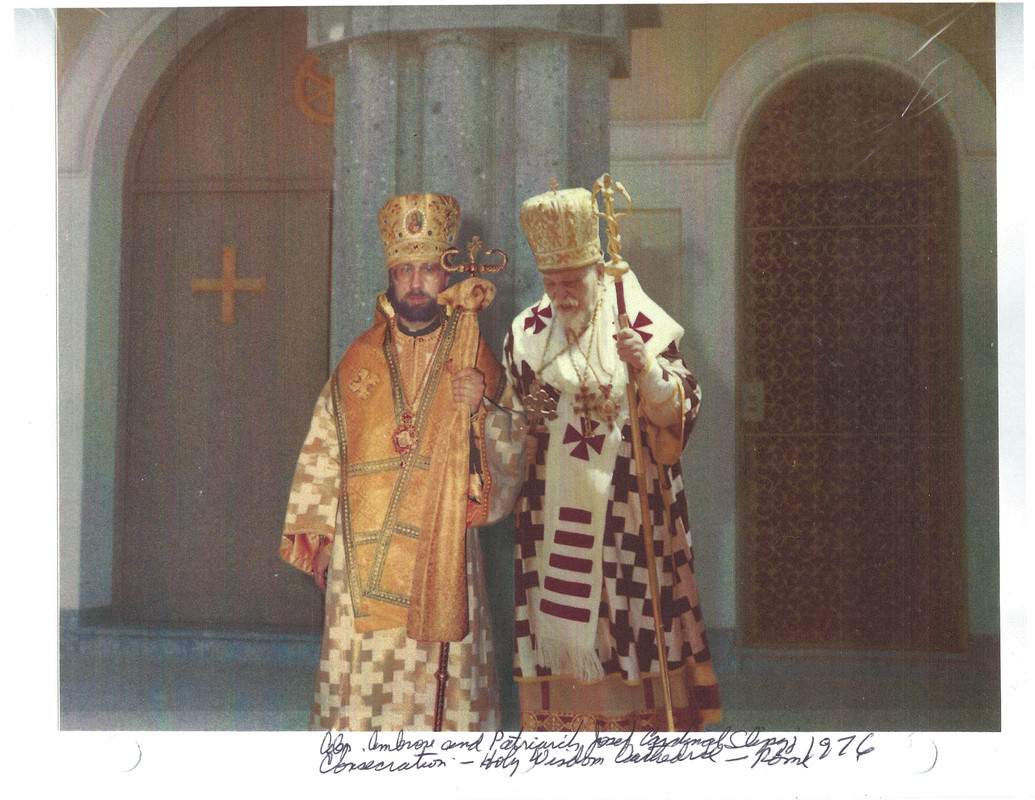
APPENDIX C
The only picture purporting to show Moran and Cardinal Cooke together. Again, note the caption in Moran’s own hand attesting to its supposed authenticity:
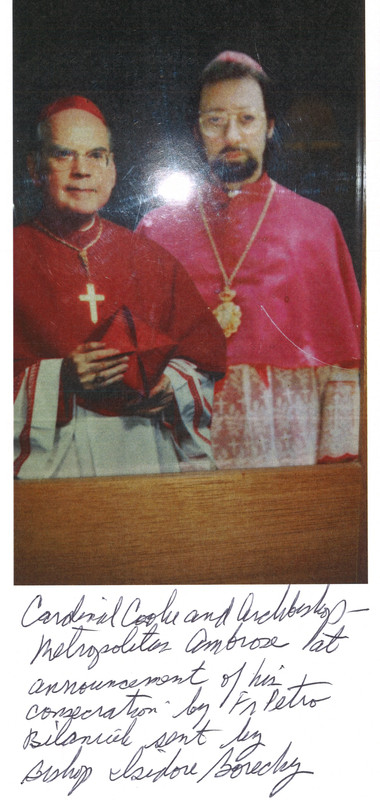
APPENDIX D
The only picture purporting to show Moran and Pope John Paul II together (this is a poor quality copy of the original in which the forgery is far more obvious) :
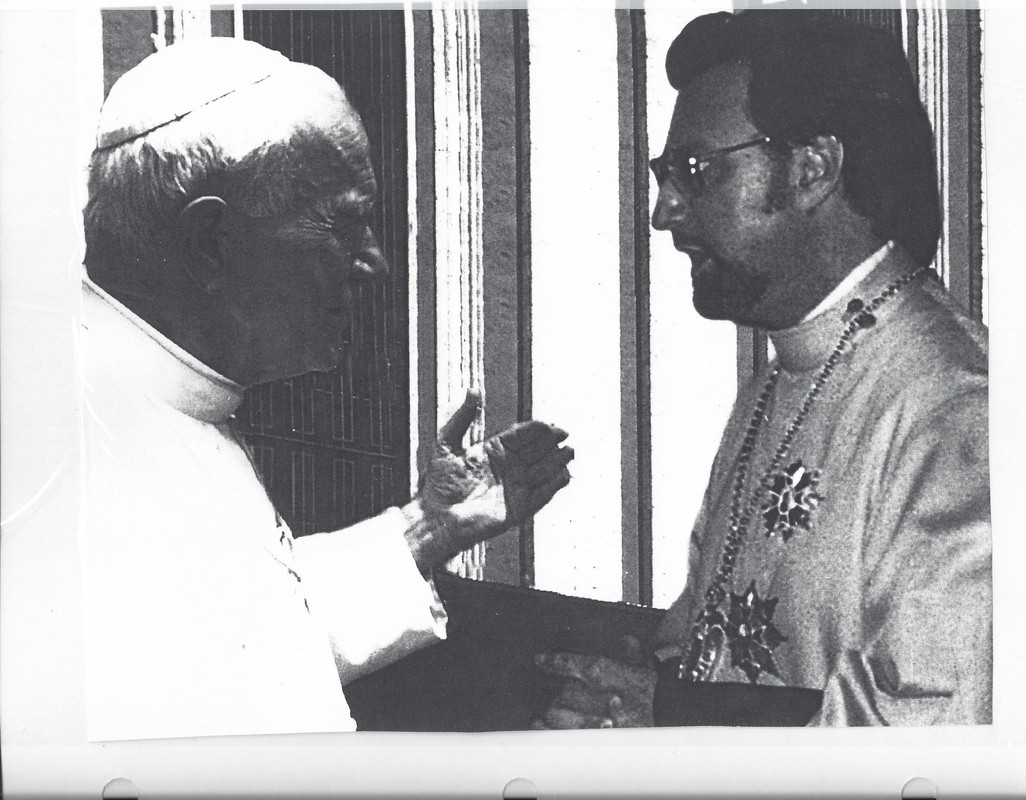
APPENDIX E
A genuine letter from Bishop Isidore Borecky to Fr. William Moran, Feb. 1975. (Note the caption added beneath the letter in Moran’s handwriting with the spurious claim that he was “a priest of the Archeparchy of Lviv” in 1974 and was then “put on loan” to Toronto Eparchy by Cardinal Slipyj in 1975) :

APPENDIX F
A forged letter purporting to come from Isidore Borecky to “Archbishop Metropolitan” Ambrose Moran, 1976:
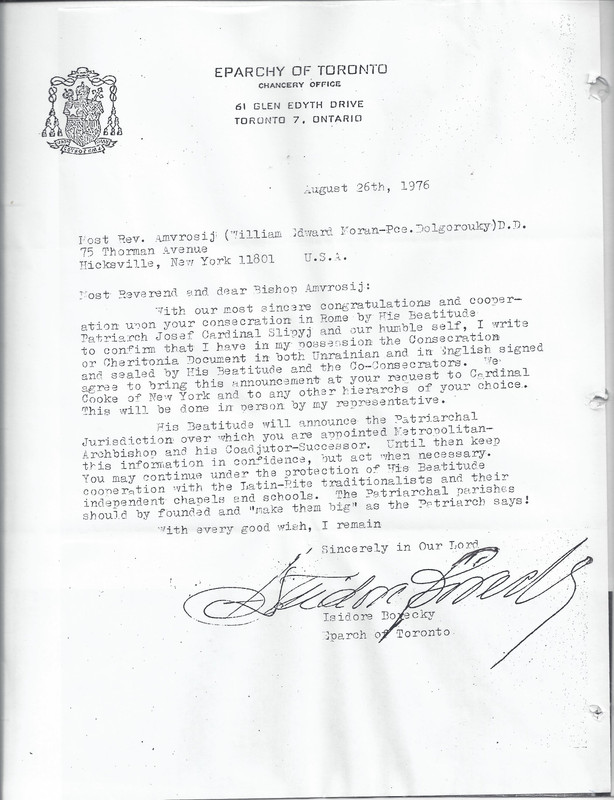
A genuine letter from Fr. “Basil” Moran to Bishop Borecky (“I have submitted” to the Orthodox Church), 1980:
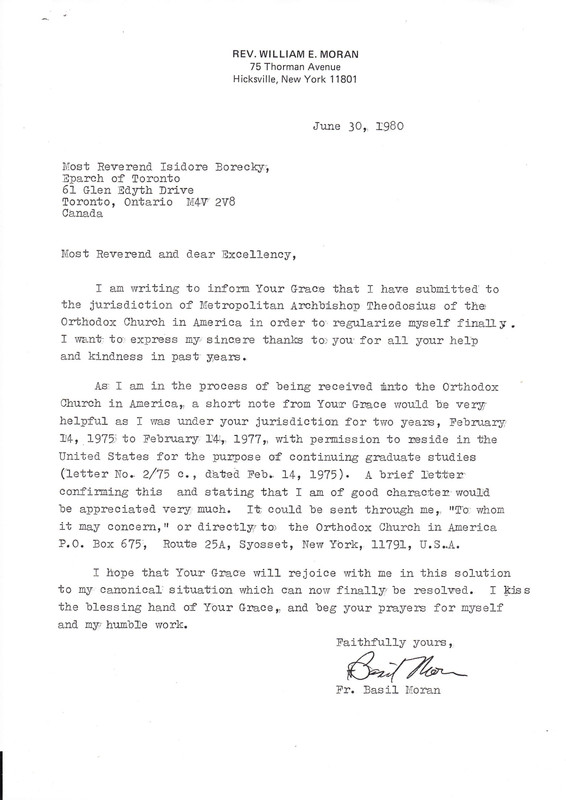
APPENDIX H
A forged certificate of consecration purportedly signed by Cardinal Slipyj in 1976 and attesting to Moran’s episcopal consecration by him in Rome in that year:
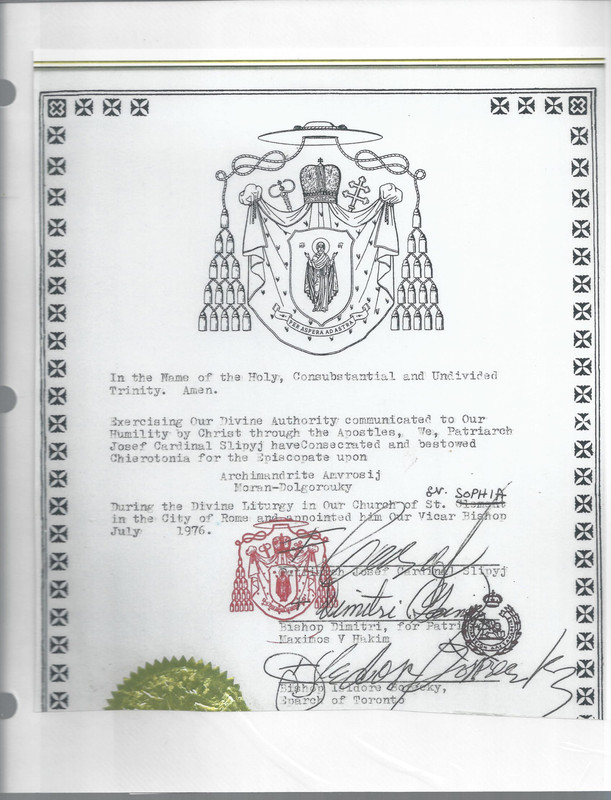
APPENDIX I
The same certificate shown on display at Moran’s home in 2015, the photograph of which is captioned in Moran’s own hand:

APPENDIX J

APPENDIX K
The same two (Moran and Gaines) outside, after the ceremony:
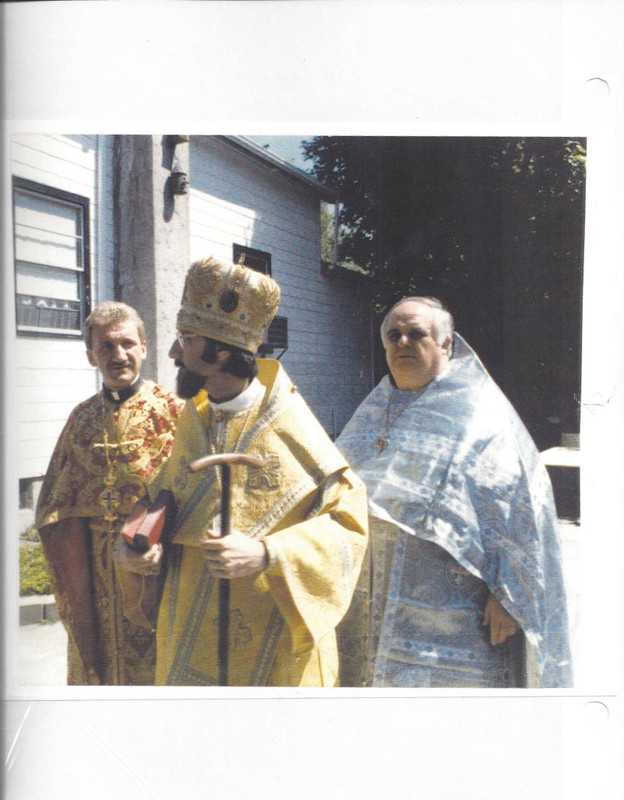

APPENDIX M
More forged pictures, this time concerning Archbishop Hrihorij (“Gregory”). In the first picture, Moran (centre) and Hrihorij (right) are two separate parts of this composite – the one superimposed onto the other. In the original, which we have seen, this is far more obvious. Like the previous pictures, the source of this picture is Moran himself.
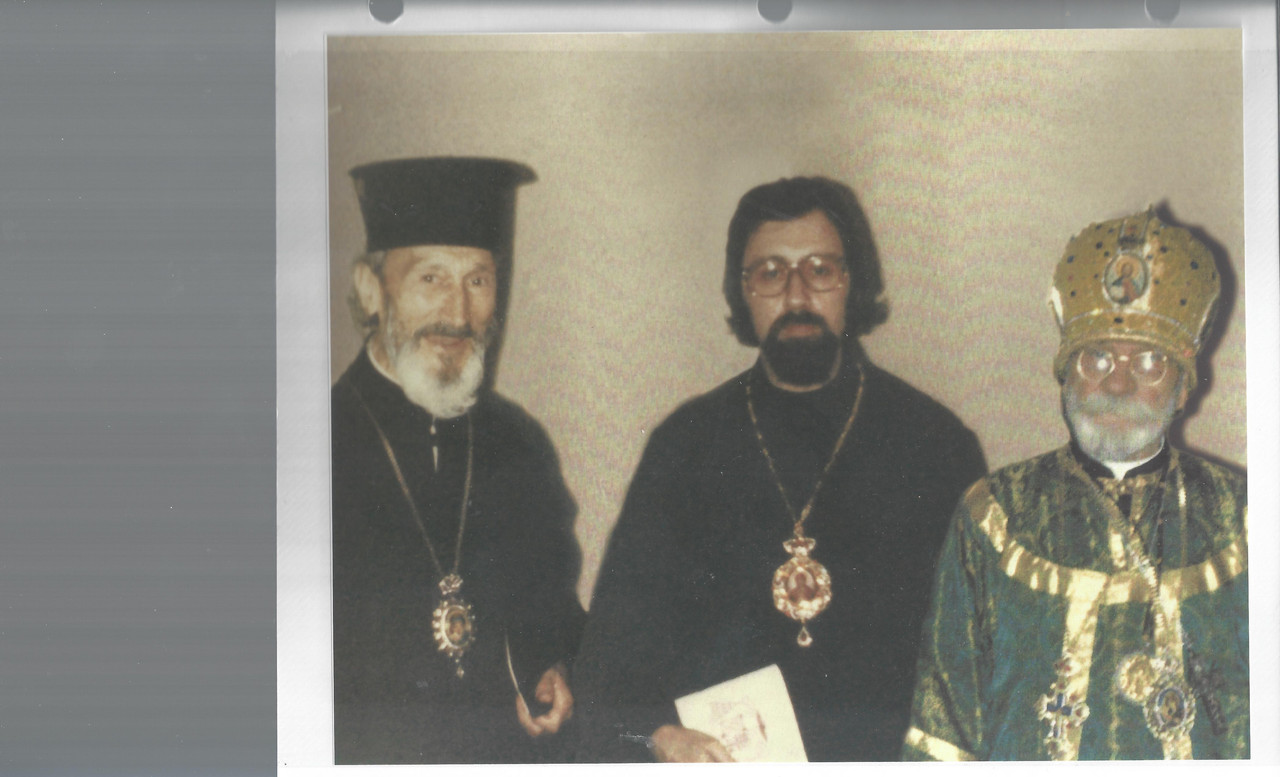
Below, a screenshot of Moran’s now defunct website. Note the same picture, but Hrihorij is now in the centre:
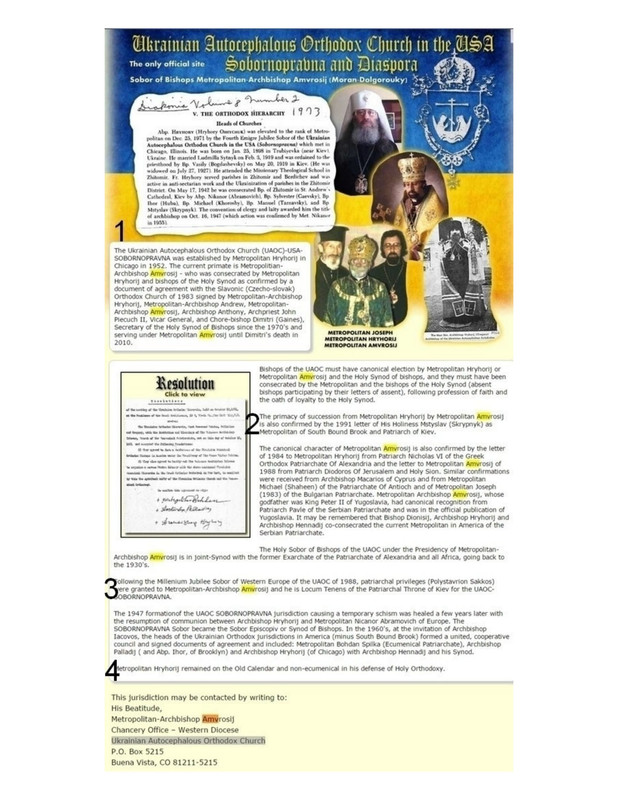
This picture has had Moran superimposed onto a photograph of Hrihorij vested in a church (preparing to offer Mass?) Notice that the superimposed image of Moran is exactly the same one used for the fake Cardinal Slipyj forgery! Also, notice the absence of anyone standing on the other side of Hrihorij.
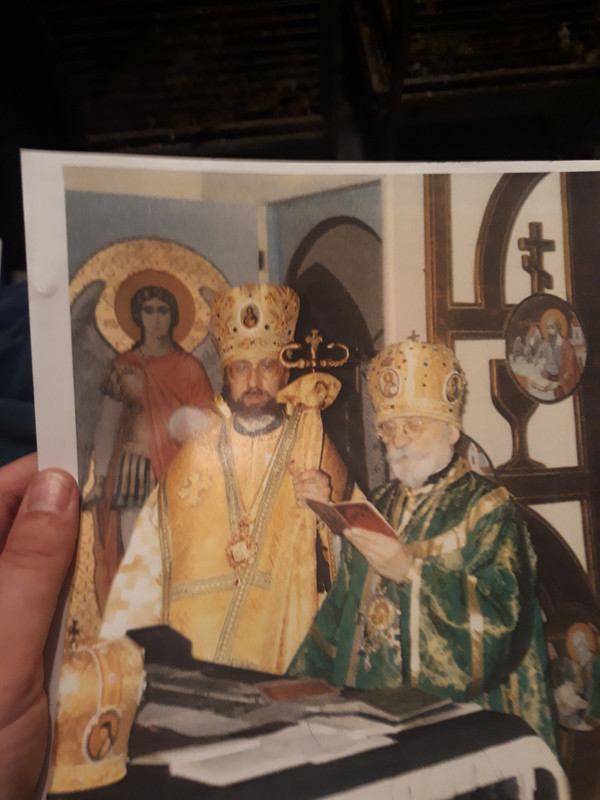
Now compare with the picture below. Spot the difference! Where did Moran go? And where did Dimitri suddenly appear from? He is not in the picture above, otherwise his vestments would have intruded into the bottom right corner of the frame. When viewing the originals, it is clear that Dimitri (who, by the way, again is only an arch-priest, not a bishop) has been superimposed in the bottom picture, just as Moran was in the top picture. Two different forgeries of the same original. Both equally fake, both equally dishonest and fraudulent.
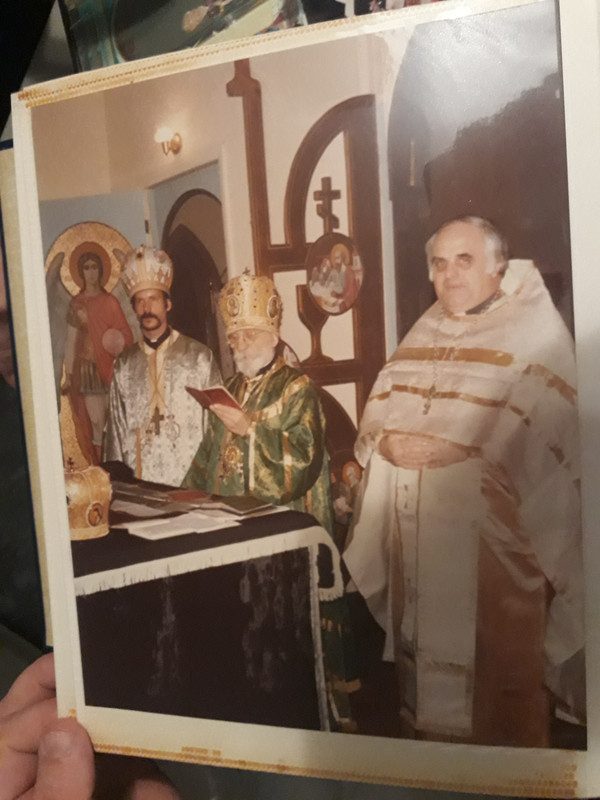
APPENDIX N - Did Ambrose Moran join the ‘Genuine Orthodox Church of America’ in 2007?
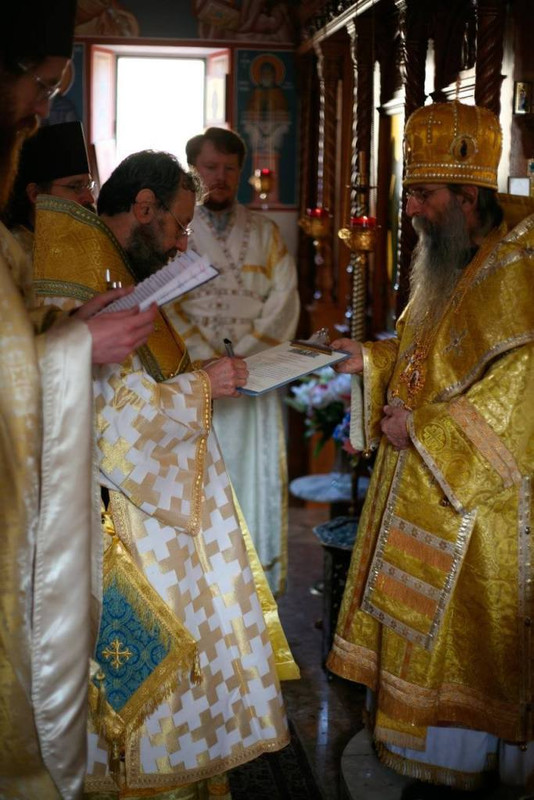
7. The three following pictures are from the episcopal consecration of Bishop John by Archbishop Gregory and Ambrose Moran in early 2008. Notice that two months after he first joined GOCA (or ‘received them into the Catholic Church,’ depending on which version you wish to believe), Moran’s episcopal ring is still missing. Does this suggest a man who was only and always Catholic? The missing ring is a small detail but an important one, because, when wearing vestments, the episcopal ring is the only distinguishing mark of an Eastern Rite bishop who is Catholic and one who is Orthodox.
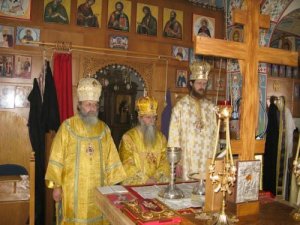
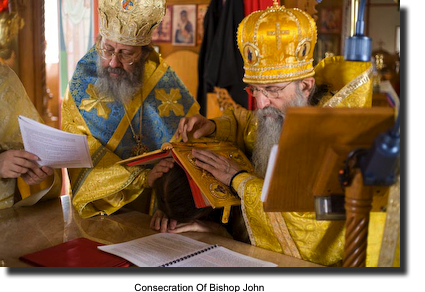
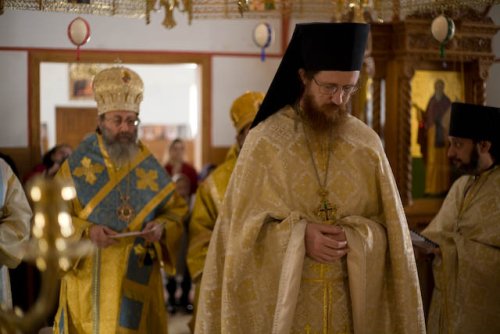
8. Conclusion.
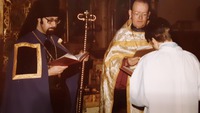
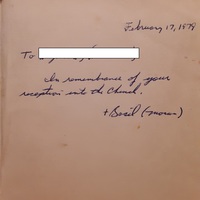
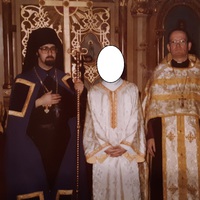
“There are people who have slandered me and my episcopate and this is a very serious matter. … There is a character out there by the name of Tony La Rosa. And he is attacking our [sic] episcopate … And I’m here to tell you that I am an Archbishop and a Metropolitan and I am the authority in the Catholic Church at this time, and you are self-condemned, Mr. La Rosa. If you were in Holy Orders I would declare you deposed, defrocked. And also you are excommunicated from the Catholic Church because of your pride and rebelliousness. … So, as a hierarch, I must declare, rule, announce, judge, that Tony La Rosa is in a state of excommunication. And I warn some of the priests that if they continue their comments and nasty behaviour, they will be deposed and excommunicated. Now you may say that I don’t have the authority to do that. I have the power to bind and to loose by virtue of the fact that I am a bishop. And I’m going to exercise that authority and jurisdiction by announcing the fact that you, tony La Rosa, have excommunicated yourself. And some of these priests soon, it will be announced that they are deposed and excommunicated. And if you want to take the chance of saying: ‘Oh that’s not true, we don’t accept that,’ – that’s fine, do that. And keep arguing that in hell. Because you will appear before the dread judgement seat of Christ, unless you repent you will appear there already condemned. This nonsense has to stop. So be it.”
(Sermon for Epiphany, available here: )
APPENDIX B
The only picture purporting to show Moran and Cardinal Slipyj together. Note the caption in Moran’s own hand:

APPENDIX C
The only picture purporting to show Moran and Cardinal Cooke together. Again, note the caption in Moran’s own hand attesting to its supposed authenticity:

APPENDIX D
The only picture purporting to show Moran and Pope John Paul II together (this is a poor quality copy of the original in which the forgery is far more obvious) :

APPENDIX E
A genuine letter from Bishop Isidore Borecky to Fr. William Moran, Feb. 1975. (Note the caption added beneath the letter in Moran’s handwriting with the spurious claim that he was “a priest of the Archeparchy of Lviv” in 1974 and was then “put on loan” to Toronto Eparchy by Cardinal Slipyj in 1975) :

APPENDIX F
A forged letter purporting to come from Isidore Borecky to “Archbishop Metropolitan” Ambrose Moran, 1976:

APPENDIX G
A genuine letter from Fr. “Basil” Moran to Bishop Borecky (“I have submitted” to the Orthodox Church), 1980:

A forged certificate of consecration purportedly signed by Cardinal Slipyj in 1976 and attesting to Moran’s episcopal consecration by him in Rome in that year:

The same certificate shown on display at Moran’s home in 2015, the photograph of which is captioned in Moran’s own hand:

Genuine pictures. Moran (as Archbishop) and Gaines (as arch-priest, in blue, standing behind) at a liturgical function in the 1980s or 90s. Note the make-shift light fixture, prefab style walls and tin roof in the background (a garage?):

APPENDIX K
The same two (Moran and Gaines) outside, after the ceremony:

APPENDIX L
Genuine picture: an example of Gaines and Moran not vested. Note that Moran clearly has the insignia of a bishop, Gaines does not (no crozier, no ring), and whereas Moran has a bishop’s panhagia, Gaines wears the small Greek cross of an archimandrite or arch-priest:
Genuine picture: an example of Gaines and Moran not vested. Note that Moran clearly has the insignia of a bishop, Gaines does not (no crozier, no ring), and whereas Moran has a bishop’s panhagia, Gaines wears the small Greek cross of an archimandrite or arch-priest:

APPENDIX M
More forged pictures, this time concerning Archbishop Hrihorij (“Gregory”). In the first picture, Moran (centre) and Hrihorij (right) are two separate parts of this composite – the one superimposed onto the other. In the original, which we have seen, this is far more obvious. Like the previous pictures, the source of this picture is Moran himself.



Now compare with the picture below. Spot the difference! Where did Moran go? And where did Dimitri suddenly appear from? He is not in the picture above, otherwise his vestments would have intruded into the bottom right corner of the frame. When viewing the originals, it is clear that Dimitri (who, by the way, again is only an arch-priest, not a bishop) has been superimposed in the bottom picture, just as Moran was in the top picture. Two different forgeries of the same original. Both equally fake, both equally dishonest and fraudulent.

APPENDIX N - Did Ambrose Moran join the ‘Genuine Orthodox Church of America’ in 2007?
The Genuine Orthodox Church of America (GOCA) claim that he did. He claims that he did not, and that he has always and only ever been Catholic. He claims that what really happened is that he went there to receive Archbishop Gregory (head of the GOCA) into the Catholic Church. The evidence seems strongly to suggest that Archbishop Gregory and the GOCA are telling the truth.
1. Archbishop Gregory is by all accounts a man of firm convictions and violently anti-Catholic. Both Fr. Pfeiffer and Fr. Hewko, having spoken to him, attest to that. Given which, it would seem prima facie that he would not want to be received into the Catholic Church and would not do anything to give anyone that impression.
2. Archbishop Gregory’s claim that Ambrose Moran had joined GOCA dates back to at least late 2007 and was made publicly on his website. And yet Ambrose, having joined GOCA in 2007, stayed with them well into 2008, June or July if I am not mistaken. I am not aware of any evidence of him publicly disputing Archbishop Gregory’s claim anywhere between 2007 and 2015.
3. Moran was received into the GOCA in mid-November 2007. He and Archbishop Gregory together performed the episcopal consecration of Bishop John in January 2008. Was Bishop John also supposed to have wished to become a Catholic? Moran’s having assisted Gregory in consecrating Bishop John for the GOCA (a man who had already been a GOCA priest and who is still to this day a GOCA Bishop) is not consistent with his story that he was really the one who received Gregory. Likewise, his having continued to live with the GOCA in Colorado for several months afterwards, until the summer of 2008, seems to me to be somehow inconsistent with the claim that he thought he was receiving them (or had received them) into the Catholic Church, not least because during all that time that he was living there, the GOCA’s own public website claimed the exact opposite, and yet he continued to live there.
4. It has been pointed out that there exist people on forums and blogs on the internet who say that Archbishop Gregory is a liar, that the GOCA cannot be trusted, and similar such things. Very well. Those people may or may not be right, but I would observe the following:
a. Ambrose Moran is without question a liar, as I believe is demonstrated above.
b. I strongly suspect that many of these online detractors have an interest in portraying GOCA and Archbishop Gregory in a negative light, they being mainstream Orthodox and he being the equivalent of the SSPX or Resistance in Orthodox terms. Imagine reading what Novus Ordo Catholics would have to say in online forums or blogs about the SSPX or the Resistance. From what I can see, Archbishop Gregory spends his time condemning all mainstream Orthodox bishops for “the heresy of ecumenism”. He doesn’t think too highly of the mainstream Orthodox: the feeling is, I suspect, mutual. There is no love lost there.
c. Even if it were true that Archbishop Gregory is a liar and cannot be trusted, it is still perfectly possible that he is a liar who happens to be telling the truth about this one event.
d. The evidence regarding the reception of Moran into the GOCA, circumstantial and photographic, does appear to support Gregory’s version of events and to contradict Moran’s, as we shall continue to see.
5. Take another look at the Police Report from Salida Police Department, Colorado, specifically of the interview which took place at the Police station between the Police Sergeant conducting the investigation and a lady by the name of Zelda Michaels. Here are the interesting parts:
East Islip is of course where Moran lived until 2007 and Dormition Skete in Colorado is the headquarters of the GOCA. Notice how Michaels says that she is Ambrose Moran’s secretary in his ministry; notice also the reason she gives for Moran having moved from Long Island to Colorado: to perform the consecration for the GOCA at Dormition Skete. There is no mention of receiving the GOCA into the Catholic Church. Notice also that he was sent “by his church” – a curious turn of phrase for someone who was always and only Catholic. Her description of herself as Ambrose Moran’s secretary is corroborated by the other Police reports and interviews with other people.
5. Take another look at the Police Report from Salida Police Department, Colorado, specifically of the interview which took place at the Police station between the Police Sergeant conducting the investigation and a lady by the name of Zelda Michaels. Here are the interesting parts:
“During the interview, Michaels described herself as an honest, hard-working woman who [had] worked for the town of Islip, Long Island, New York. […] Michaels said she is the secretary/treasurer for Archbishop Ambrose’s ministry. […] Michaels said that Archbishop Ambrose became a close friend of hers and even lived in her home in New York for a time until he was sent by his church to Buena Vista, Colorado to assist in the consecration of a bishop at the Dormition Skete monastery.”
6. The following picture was taken in late 2007 at what Archbishop Gregory and the GOCA claim was the reception of Moran into their Church, and what Moran claims was really the other way around. Moran is the one standing on the left, Gregory on the right. Let us look carefully at the picture and notice the difference between the two men:
• Gregory is stood in the sanctuary facing down the church, Moran is stood outside the sanctuary facing in.
• Moran’s head is bare, whereas Gregory is mitred.
• Gregory is standing higher up, on the steps, Moran lower down, on the floor of the Church.
• Moran is the one signing the clipboard, not Gregory.
• Moran is not wearing his episcopal ring.
Perhaps it will be objected that they must surely both have signed the clipboard – then where is the picture of Gregory signing it and why, as far as we know, did only one of them sign it during the ceremony? Furthermore, the absence of the episcopal ring is very telling, a ring being one of few differences between how an Eastern-Rite Catholic and an Orthodox bishop dress. In all the other photos of Moran as a bishop he is wearing it. But here he is not – why? All of these details are small but important – they are all consistent with what Archbishop Gregory says.




The evidence, photographic, documentary and circumstantial, suggests that Archbishop Gregory is telling the truth, that Ambrose Moran did join the GOCA in 2007. Letters and signed declarations exist on the internet avowing schismatic Orthodoxy as the true Faith and anathematising the mainstream Orthodox for the heresy of ecumenism, signed by Moran on his reception by Gregory into the GOCA. Examining these documents as evidence in themselves would be fruitless since Moran is able simply to claim that they are fabrications, lies invented by Gregory, and that he never signed them, whereas Gregory claims that they are genuine and that Moran did sign them. Taken on their own, therefore, they do not get us anywhere. Taken against a background of the other evidence mentioned above, they make far more sense and are in all likelihood genuine. Having examined them myself, I cannot find any of the tell-tale signs of forgery present in some of Moran’s alleged documents or photographs.
It seems to me more than likely that 2007 was in some ways a repeat of 1980: Moran, who had been hitherto ‘canonically homeless,’ found himself a home in a small offshoot of the schismatic Orthodox Church. He did not last there very long, just as he has did not last very long with the ‘Orthodox Church in America’ or with Holy Protection Cathedral in Chicago or indeed even with Toronto Eparchy. His latest intended ‘home’ is the Resistance, and in order to make himself acceptable to these Catholics, he has been telling lies to try to cover up his involvement with the schismatic Orthodox, including his having joined GOCA in 2007.
It seems to me more than likely that 2007 was in some ways a repeat of 1980: Moran, who had been hitherto ‘canonically homeless,’ found himself a home in a small offshoot of the schismatic Orthodox Church. He did not last there very long, just as he has did not last very long with the ‘Orthodox Church in America’ or with Holy Protection Cathedral in Chicago or indeed even with Toronto Eparchy. His latest intended ‘home’ is the Resistance, and in order to make himself acceptable to these Catholics, he has been telling lies to try to cover up his involvement with the schismatic Orthodox, including his having joined GOCA in 2007.
It is a serious thing to accuse another publicly of being a liar and one should avoid doing so without serious grounds and without there being a serious necessity which requires you to do so in the interests of the common good. Having tried to give Ambrose Moran the benefit of the doubt, having studied the evidence as carefully as possible, and having given the matter quite a lot of time to turn over in my mind so as not to jump to conclusions, I find myself led again and again to the inescapable conclusion that Moran is indeed a liar. In fairness and justice, the same benefit of the doubt ought equally to apply to Archbishop Gregory of Colorado, who also cannot be called a liar without serious evidence and a serious need. From everything I have seen regarding this episode, Archbishop Gregory appears, at least in this instance, to be an honest man who has told the truth.
APPENDIX O - More evidence of “Fr. Basil Moran”, Orthodox priest, in 1979
APPENDIX O - More evidence of “Fr. Basil Moran”, Orthodox priest, in 1979
In September 2019, the following appeared on “The Catacombs” website, ostensibly from the pen of an Orthodox priest. It throws a little light on the true story of Ambrose Moran, particularly what he was up to in the period of the late 1970s – early 1980s, when he was no longer a priest of Toronto Eparchy, but not yet presenting himself as a bishop. Worthy of note are the following points:
• Moran presented himself as a priest, not a bishop, even though, according to his later tale, this would have been fully three years after he became a bishop (at the hands of Cardinal Slipyj, as he claims);
• Moran presented himself as Orthodox, not Catholic, once again giving lie his claim to only ever have been Catholic;
• Even at that stage he was an unattached drifter, a “vagus” priest; note that the Orthodox priest at whose church Moran had presented himself considered Moran “uncanonical” as he did not belong to any recognised Orthodox jurisdiction. This was 1979; it is corroborated entirely by Moran’s 1980 letter to Borecky (“…rejoice with me in this solution to my canonical situation”).
• One of the images supplied by the author (Fr. David) is a personal note written in Moran’s handwriting, signed and dated, congratulating the layman on being received into “the Church”. Since the “church” into which the layman had just been received was one of the schismatic Orthodox Churches, and since the layman in question had been a Catholic until then, what this means is that Moran personally congratulated him on leaving the Catholic Church and becoming a schismatic Orthodox.
Friends, full disclosure: I am an Orthodox priest. I have never met nor had any contact with Ambrose Moran. I have no grudge against him, no reason to wish him ill, and no dog in the inter-traditional Catholic fight. However, since it seems that most of the information about Ambrose/Basil/William Moran has been supplied by the man himself, I wanted to contribute a bit of anecdotal evidence that I learned from a person who did know him several decades ago.
Friends, full disclosure: I am an Orthodox priest. I have never met nor had any contact with Ambrose Moran. I have no grudge against him, no reason to wish him ill, and no dog in the inter-traditional Catholic fight. However, since it seems that most of the information about Ambrose/Basil/William Moran has been supplied by the man himself, I wanted to contribute a bit of anecdotal evidence that I learned from a person who did know him several decades ago.
My father grew up in Passaic, New Jersey. He knew “Fr. Bill” Moran when he was a young man. Ironically, my father even has a distinct memory of being at St. Nicholas Ukrainian Catholic Church in Passaic when Cardinal Slipyj visited in the 1970s. “Fr. Bill” stood in the choir loft. (Of course, this must have been to stay undercover as Slipyj’s coadjutor!)
While my father was raised in the Catholic Church, at the age of 17 he decided to become Orthodox. He was received into the Orthodox Church on February 17, 1979. Now calling himself “Archimandrite Basil” (archimandrite is an honorific title given to monastic priests) and claiming to be Orthodox, Moran showed up uninvited to the service of reception into Orthodoxy. It is important to note that Moran was what we in the Orthodox world often term “uncanonical”—he was not a member of a recognized Orthodox body. However, Moran knew the priest of the (canonical) church, and that priest did allow him to stand at the front of the church without actually participating in the service.
I am attaching two photographs from this event. While untrained eyes may think he is dressed as an Eastern bishop since he is in mantya (mantle) and klobuk (black hat with veil) and holding a staff, he is in fact dressed in an archimandrite's choir dress, with two pectoral crosses. A bishop would wear an “engolpion” or “panagia”, a round medallion with an icon. So, at least on this occasion in 1979, he was not presenting himself as either Catholic or a bishop.
I am also attaching a photo of an interesting inscription he wrote in a service book he gave to my father on that occasion, congratulating him on being received into “the Church.”
Now, all this begs the most important question: if Moran was consecrated by Slipyj in 1975, was always staunchly Catholic, always commemorated the Pope, etc., why would he attend (in full regalia) an event wherein someone very publicly "apostatized" from the Catholic Church? The service itself included abjuration of Catholicism. Why would he offer his congratulations for this and even put this into writing? On February 17, 1979, it seems Moran believed that the Orthodox Church was THE Church, and that the Catholic Church was not. This obviously does not square with his repeated claims.
My father and I were surprised when, after many years, Moran resurfaced for a time with “Archbishop” Gregory AbuAsaly of Dormition Skete in Colorado. After he faded into the background again, we were even more amused to see him appear among traditional Catholics claiming to be Cardinal Slipyj’s hand-picked yet secret successor!
I have no idea whether Moran was ever validly ordained a bishop by independent Ukrainian bishops, but that is really a moot point. He behaves like a typical “episcopus vagans”--constantly seeking validation anywhere he can find it. Moran seems quite intelligent, has a vast knowledge of the Orthodox and Catholic worlds, and knows how to tailor himself to his audience. When he sought a place in traditionalist Orthodoxy, he claimed amazing things like being tonsured a monk by St. John Maximovich of San Francisco. Once he set his sights on traditional Catholicism, he began to weave a narrative specifically for that purpose.
If Ambrose Moran reads this post, he may respond (in a video denunciation?) that an "apostate" from the Catholic Church cannot be trusted, and/or that my message is part of a grand conspiracy of the Orthodox to defame him for joining the Catholic Church. However, I hope those who already doubt or discount Moran's claims will see this small bit of information as confirming their correct assessment.
With best regards,
Fr. David
Fr. David



